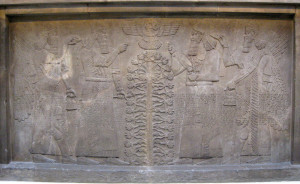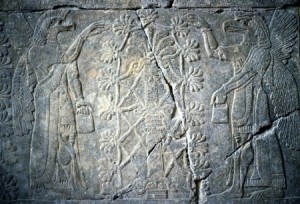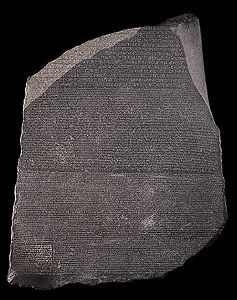Gracias a Lisa Velazquez por traducir este articulo. Puede escucharla a traves de Teshuva.tv los Domingos a las 6pm en el programa radial: Caminando en Obediencia.
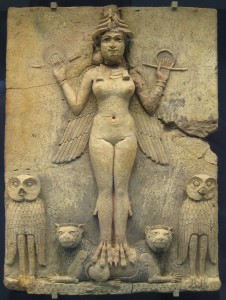 (En la foto, Ishtar como diosa velada / patrona del amor y la pasión con sus emblemas habituales de leones, así como búhos, que denotan su posición como patrona de las prostitutas)
(En la foto, Ishtar como diosa velada / patrona del amor y la pasión con sus emblemas habituales de leones, así como búhos, que denotan su posición como patrona de las prostitutas)
Ha llegado a mi conocimiento que algunas personas piensan que no soy consciente de que Ishtar es una diosa pagana. Volví a leer mi blog y estoy seriamente luchando en imaginarme el por qué alguien podría pensar que estoy creyendo que ella es real. Este es un estudio del contexto bíblico y estoy enseñando el contexto AMO [Antiguo Medio Oriente] quién es ésta Ishtar y el por qué se adoraba junto a Dios en Su templo. Por favor lea, y si usted tiene alguna pregunta – eche un vistazo al resto de mi blog o deme el respeto al preguntarme sobre ello. Incluso he mencionado al Mesías en mi blog. No sé cómo más clara pueda ser.
Estoy escribiendo esto como una continuación de mi blog acerca de Tamúz, y otra vez, publico una pedido en favor a la civilidad. Escribí un libro que incluía la frase “domingo de Ishtar” sin hacer mis debidas investigaciones. Más de 70,000 palabras de referencias bíblicas cuidadosamente investigadas y lo arruiné todo por simplemente repetir algo que “todo el mundo” sabía. Muchas personas que yo respetaba como maestros y líderes en los últimos diez años dijeron que tomé su veracidad por sentado. La información que presento viene en una pérdida de mi propia facha, pero sólo después de una gran cantidad de investigación sobre la evidencia arqueológica e histórica que tenemos de Ishtar y su adoración durante el cuarto hasta mediados del primer milenio. Tenemos a nuestra disposición, epopeyas y rituales de culto en tablillas cuneiformes, esculturas, estelas, sellos, descripciones contemporáneas de su culto durante su período de tiempo, templos excavados – en verdad tenemos más información sobre Ishtar que cualquier otra deidad mesopotámica. Incluso sabemos los detalles minuciosos de su administración de templo. Ella fue la diosa más amada y poderosa en el panteón mesopotámico por miles de años – incluso alcanzando la esfera hebrea a la altura del poder de Babilonia a mediados del primer milenio. Sabemos quién la adoraba y el por qué, sabemos de sus cónyuges – hombres, dioses e incluso varios animales. Sabemos cómo se celebraba su culto, y cómo se ataviaban sus sacerdotes. Sabemos más acerca de su vida sexual más de lo que yo desearía saber. Sabemos de sus símbolos de culto, y tenemos evidencia de su culto a lo largo de cuatro milenios separados. Presento esta evidencia como un mea culpa, admitiendo mi complicidad en la perpetuación de algo que yo misma no había estudiado. Esta presentación será breve y sólo cubrirá los aspectos más destacados – Podría escribir un libro sobre ella, pero me abstendré de hacerlo.
Lo que presento puede hacerte enojar, pero daré todas mis fuentes, y si después de repasarlas todavía no está de acuerdo conmigo, entonces no puedo hacer nada al respecto, pero les advierto que no reaccionen con enojo a mis conclusiones honestas. Esto no se presenta en contra de ningún ministerio (excepto tal vez el mío), pero en la búsqueda de la verdad – que siempre debemos buscar y nunca conformarnos con menos pues no seremos mejores que cualquier religión que decimos habernos apartado de. Recuerden por favor que soy su hermana, y no alguien a quien insultar. Lo que voy a presentar es tan reñido como con lo de Alexander Hislop de Las Dos Babilonias en todos los aspectos (vea el blog de Tamuz para más información sobre el reverendo Hislop), de hecho, no he encontrado ni siquiera una pizca de evidencia de las afirmaciones que muchos ministerios hacen sobre su supuesta conexión con los rituales de Easter. Si hay algo de verdad en las afirmaciones de Hislop en el siglo 19, por ahora alguien habría encontrado algo. Su libro fue desacreditado en la década de 1920 y todavía sigue siendo uno de los favoritos entre los que quieren pruebas contra cosas que están asociadas con la Iglesia Católica. Que quede registrado, no tengo amor por la Iglesia Católica, ya que arrojaron a mi abuela halándola por su oreja, después de que su marido la abandonó y se divorció de ella con tres niños en la década de 1950 – pero yo no los odio suficiente para no aclarar las cosas. Así pues, aquí les dejo un breve resumen de mis conclusiones, seguido de una extensa bibliografía.
Ishtar (acadio) e Inanna (sumerio) eran diferentes nombres de la misma diosa mesopotámica – ella era la reina indiscutible de los cielos, no hubo otra diosa en cualquier cultura, incluso que igualara su destreza. Ella era originalmente la diosa del comercio y la fertilidad asociada a él, se convirtió en la diosa encargada de darles a los reyes su autoridad, y en días posteriores era la diosa de la guerra, la pasión y las prostitutas. Ella era – como Inanna, representada como la hija virginal y joven ávida novia, entonces como Ishtar, que se caracterizó por su larga lista de relaciones desastrosas (como se detalla en la epopeya de Gilgamesh donde enumera sus múltiples amantes que llegaron a extremos maléficos). Su famoso matrimonio con Dumuzi (Tamúz) bajo el nombre de Inanna a veces se pinta en tonos amables, como cuando él fue asesinado por bandidos que amortiguaron su cabeza, mientras le robaban su ganado, y a veces en tonos brutales, como cuando ella contrató a demonios para llevárselo al inframundo con el fin de intentar sin éxito robarle el trono de su hermana. Ella o ayudaba a su hermana, la diosa de la vid, junto a su madre en la búsqueda de su marido asesinado, o era la causa que su madre y su hermana lo buscaban a él.
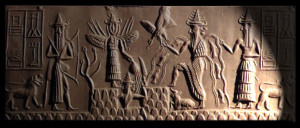 Extrañamente, en un mundo donde las diosas son retratadas de manera rutinaria como madres – ella no lo fue. Ishtar fue la novia virginal, o la amante apasionada o en tiempos posteriores la patrona de las prostitutas o – de los travestis. Aquí la vemos junto a los otros dioses del Poema de Gilgamesh.
Extrañamente, en un mundo donde las diosas son retratadas de manera rutinaria como madres – ella no lo fue. Ishtar fue la novia virginal, o la amante apasionada o en tiempos posteriores la patrona de las prostitutas o – de los travestis. Aquí la vemos junto a los otros dioses del Poema de Gilgamesh.
La adoración a Ishtar tomó varias formas – se instituyeron lamentos, tal vez, en nombre de su esposo Tamúz, así como el ritual del matrimonio sagrado en que los reyes de Mesopotamia promulgaban su matrimonio real con Ishtar como una forma de consolidar su derecho al trono. En estos últimos días, sus sacerdotes se travestían y se comportaban como travestis durante sus festivales muy extraños – festivales que participan en la práctica de juegos de niños, a la edad en general, estatus y confusión de género. No había impregnación de vírgenes, y la religión babilónica no se incluía el sacrificio humano en algún cuento que pude hallar – a pesar de tener una gran cantidad de información. E incluso si, en algún un momento, se había incluido el sacrificio humano – Crassus lo proscribió en los años 90 AEC por todo el Imperio Romano, y señaló que sólo se llevaría a cabo antes de esa rara y en relación con las artes mágicas, y no en el culto regular de dioses o diosas (Pliny the Elder, Natural History XXX). El sacrificio humano fue considerado como bárbaro y “no-romano,” la misma actitud que tenían hacia la práctica del aborto.
El sacrificio de animales era común en la adoración de Ishtar – pero entonces era común en todas las formas de adoración en el Antiguo Medio Oriente y el Primer siglo. Los dioses y diosas tenían templos por una razón principal – para que sus siervos humanos atendiesen sus necesidades físicas mientras ellos realizaban sus funciones cósmicas. Ishtar tenía que proteger al rey, ella supervisaba el almacén, evitando el hambre – si Ishtar pasaba tiempo en la recolección de alimentos y bebidas para ella, entonces ella podría distraerse y el caos sobrevendría. Éste fue el punto de vista antiguo de toda adoración a los dioses – cuidar de ellos. En la parte superior de su zigurat había una pequeña casa – en el interior había habitaciones. El ídolo que proporciona acceso a la esencia de la deidad se le despertaba por la mañana, se bañaba y se vestía con sus mejores galas, se alimentaba con las partes más selectas, se le adoraba, y luego se le volvía a poner en la cama por la noche. Mientras se atendía a Ishtar, ella era libre de hacer su trabajo importante del cuidado de sus funciones en el universo. El sacrificio de animales era simplemente una manera de proporcionarle el alimento que necesitaba para sobrevivir. Ella no tenía ningún vínculo con la adoración del domingo o fiestas que se celebran en ese día – como todos los dioses y diosas, ella era adorada y cuidada todos los días. Ella tenía dos festivales que se celebraban en la salida y la puesta del planeta Venus en el invierno y el verano, ocho meses de diferencia – pues ella era también conocida como la estrella de la mañana y la tarde.
 Los símbolos de Ishtar eran el león y la estrella de seis puntas (a veces de ocho puntas) dentro de un círculo (que no se parece a la estrella de David en la mayoría de los casos) y, a veces la estrella de ocho puntas (la imagen de la izquierda no es el mejor ejemplo, por desgracia, el Museo Británico tiene una excelente impresión de sello cilíndrico pero no está disponible en línea). Ella a menudo es representada ya sea de pie, o montando un león, o con una maza león de dos cabezas y una espada enganchada llamada harpe. Ella nunca se representa con conejos ni huevos ni tampoco ninguno de sus rituales o leyendas hacen mención de ellos. Ella a menudo es representada desnuda, como la diosa del amor y la pasión, o llevando un extraño sombrero puntiagudo junto con las armas de guerra como la Dama de Batalla. Para el tiempo del Mesías, el culto a Ishtar era prácticamente inexistente.
Los símbolos de Ishtar eran el león y la estrella de seis puntas (a veces de ocho puntas) dentro de un círculo (que no se parece a la estrella de David en la mayoría de los casos) y, a veces la estrella de ocho puntas (la imagen de la izquierda no es el mejor ejemplo, por desgracia, el Museo Británico tiene una excelente impresión de sello cilíndrico pero no está disponible en línea). Ella a menudo es representada ya sea de pie, o montando un león, o con una maza león de dos cabezas y una espada enganchada llamada harpe. Ella nunca se representa con conejos ni huevos ni tampoco ninguno de sus rituales o leyendas hacen mención de ellos. Ella a menudo es representada desnuda, como la diosa del amor y la pasión, o llevando un extraño sombrero puntiagudo junto con las armas de guerra como la Dama de Batalla. Para el tiempo del Mesías, el culto a Ishtar era prácticamente inexistente.
Ella nunca se menciona en referencia a Semiramis, la reina mesopotámica del siglo 12 que vivió poco antes del rey David, la cual no estuvo casada con Nimrod, ni tuvo un hijo llamado Tamúz – pero eso es para otro blog.
Sólo por causa de información – No utilizo a Heródoto como una fuente fiable para cualquier cosa fuera de la cultura griega, como fue notorio por simplemente escribir todas las historias de segunda mano que él oyó. Sus escritos sobre Egipto, por ejemplo, no sólo han ido sin fundamento, pero han sido refutados en gran medida.
Soy consciente de que este blog es corto, pero Ishtar es demasiada compleja para ser cubierta de manera adecuada en un blog y no sería apropiado entrar en gran detalle de todos modos. Usted tiene mis recursos, que se enumeran a continuación – estoy bastante segura de que los enlisté todos, pues mi biblioteca está hecha un reguero en el momento.
Bibliografía
(Estos son todos los libros y artículos que he leído, además de los relacionados con Tamúz porque todas las historias sobre él hablan también de ella – asegúrese de revisar cada referencia a Inanna, Ishtar (o Istar), Dumuzi y Tamúz Pero una advertencia al lector, la literatura de Ishtar es a menudo de naturaleza sexual atroz)
The Treasures of Darkness: A History of Mesopotamian Religion, Thorkild Jacobsen (PhD en Asiriología, el individuo incluso enseñó en Harvard, durante su vida y hasta ahora se le considera uno de los principales expertos en el Antiguo Medio Oriente)
The Babylonian World, Gwendolyn Leick, Ed – He descargado esto desde scribd.com, lo cual ha valido la pena la suscripción $50 al año. Capítulos 7 y 22-24 fueron especialmente útiles.
A Dictionary of Ancient near Eastern Mythology, Gwendolyn Leick, (PhD Asiriología)
The Ancient Near East: An Anthology of texts and Pictures, James B Pritchard, Ed (todos los libros de Pritchard tienen pedigríes impresionantes y éste no es diferente – es la obra de diecisiete estudiosos serios del AMO)
The IVP Bible Background Commentary, John Walton et al. Comentario sobre Ezequiel 8
Myths from Mesopotamia, Stephanie Dalley
Handbook of Life in Ancient Mesopotamia, Stephen Bertman
Interpreting the Past: Near Eastern Seals, Dominique Collon
The Ishtar Temple at Ninevah, Julian Reade, Irak, Vol 67, No 1, Nínive. Los trabajos de la 49ª Recontre Assyriologique Internationale, la segunda parte (primavera de 2005) paginas 347-390
Ishtar, the Lady of Battle, Nanette B Rodney, Metropolitan Museum of Art Bulletin (esto se puede encontrar en línea si se busca por título y autor, pero como no he visto cualquier otro artículo serio o de igualación a Ishtar con Astarté, deje que el lector tenga cuidado en ese punto)
Inanna-Ishtar as Paradox and a Coincidence of Opposites, Rivka Harris, History of Religions, Vol 30, No 3 (Febrero 1991), paginas 261-278 (artículo muy bueno, sino más bien chocante, que detalla algunos de sus festivales)
A New Ishtar Epithet in the Bible, Joseph Reider, Journal of Near Eastern Studies, Vol 8, No 2 (Abril 1949) paginas 104-107
On the Entymology of Ishtar, George A Barton, Journal of the American Oriental Society, Vol 31, No 4 (1911) paginas 355-358 (lo incluyo porque lo leí pero es realmente sólo será interesante si le gusta la lingüística)
The White Obelisk and the Problem of Historical Narrative Art of Assyria, Holly Pittman, The Art Bulletin, Vol 78, No 2 (junio 1996), paginas 334-355 (sólo escobillas sobre Ishtar, pero si usted está interesado en obeliscos asirios del primero y segundo milenio de la arqueología asiria, lo encontrará fascinante)
Toward the Image of Tammuz, Thorkild Jacobsen History of Religions, vol. 1, No. 2 (Winter, 1962), paginas 189-213 (disponible en JSTOR.org)
Tammuz and the Bible (éste fue genial), Edwin Yamauchi, Journal of Biblical Literature Vol. 84, No. 3 (Septiembre 1965), paginas 283-290 (también disponible en JSTOR.org)
 So, as you know I only share my dreams if they are relevant for the entire Body. Last night’s fell into that category.
So, as you know I only share my dreams if they are relevant for the entire Body. Last night’s fell into that category.
